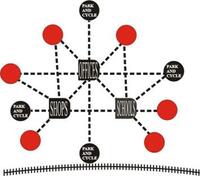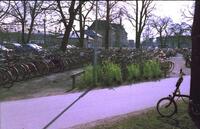- England
- Scotland
- France
- Holland
- Germany
- Italy
- Spain
- Portugal
- USA
- China
- Japan
- India
- Iran
- Advice
- Gardens
- England
- Scotland
- France
- Holland
- Germany
- Italy
- Spain
- Portugal
- USA
- China
- Japan
- India
- Iran
- Advice
- Garden Tours
Book: Landscape Planning and Environmental Impact Design: from EIA to EID
Chapter: Chapter 2 Landscape plans for public goods
Improved transport policy is the grand avenue to sustainable cities. Commuting by public transport is more sustainable than commuting by car. It requires less resource-input and produces fewer wastes. Green commuting by human power is better still. Journeys and part-journeys to work by foot, bicycle, canoe or ice-skates, are environment-friendly. They do not waste scarce energy resources, propagate air pollution, or generate noise. Nor do they cause acid rain or damage the ozone layer. Green commuting can lead to tremendous savings on the public healthcare budget, by reducing stress, diminishing obesity, decreasing cancer risks, curtailing road accidents, easing asthma and other respiratory diseases. It used to be said that what was good for General Motors was good for America . It wasn't true then and it's less true now. A cost-benefit analysis would show enormous positive balances on policies to facilitate green commuting and discourage red commuting. What's good for green commuters is good for America . That's it. Journeys to work are much more likely to be made on foot or bicycle in cities which have good pedestrian and cycleway systems. Who can doubt it? Travelling beside a busy road, being choked with fumes, deafened by noise and splashed by passing vehicles is a punishing experience [Fig 2.19]. One arrives feeling like an exhausted warrior in need of a hot bath and toasted muffins. Walking or cycling down a leafy path or lane, looking at the flowers, chatting to one's friends and listening to the birds, or a personal stereo, is a great pleasure. Those who live more than half an hour from their place of work may think the journey too far to walk or cycle, but the first and last sections of their journeys can still be made by green transport modes, if and when cities are properly planned and designed. Every important destination, including schools, stations and shopping centres, should be the hub of foot- and cycle-paths. [Fig 2.20] Destinations should become hubs for footpaths and cyclepath networks. Adults driving their children to school or their spouses to the station cause additional traffic congestion. This should be discouraged. If developers are asked to contribute to infrastructure costs (eg roads and sewers) they should also be asked to contribute to the cost of green commuter routes and safe cycle storage at transport interchanges [Fig 2.21]. Fig 2.21a Bicycle park outside the rail station in Uppsala

